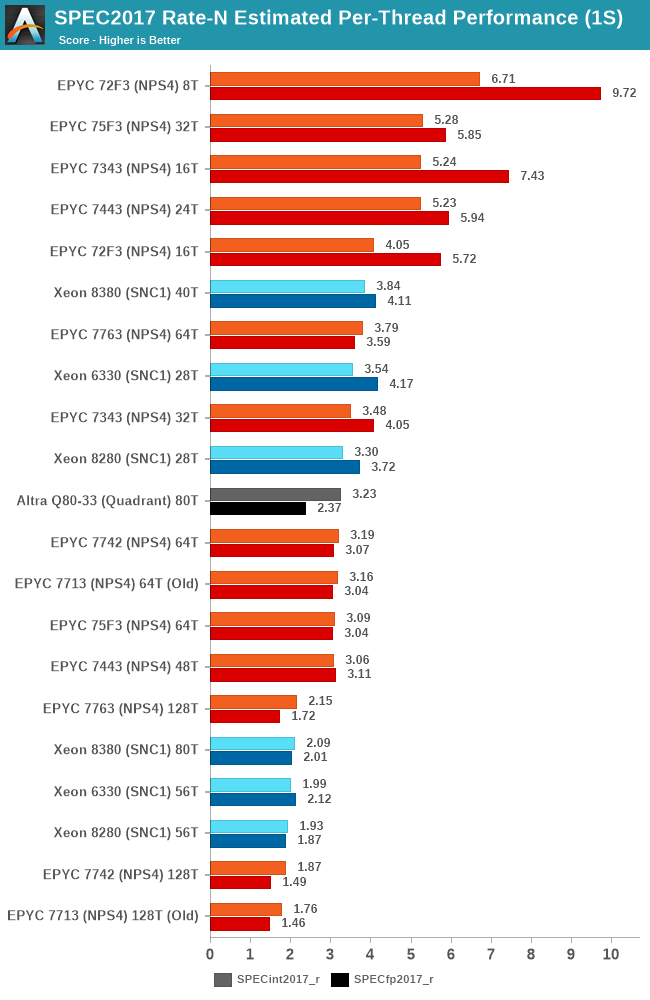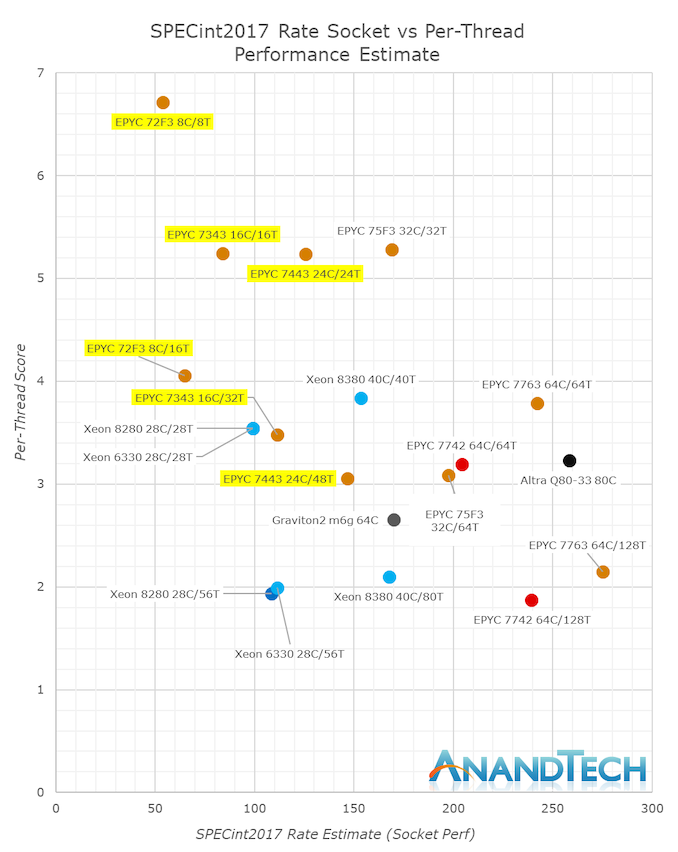AMD EPYC Milan Review Part 2: Testing 8 to 64 Cores in a Production Platform
by Andrei Frumusanu on June 25, 2021 9:30 AM ESTSPEC - Per-Core Performance under Load
A metric that is actually more interesting than isolated single-thread performance, is actually per-thread performance in a fully loaded system. This actually is a measurement and benchmark figure that would greatly interest enterprises and customers which are running software or workloads that are possibly licensed on a per-core basis, or simply workloads that require a certain level of per-thread service level agreement in terms of performance.
It’s also here where AMD’s new low-core count SKUs are extremely interesting, allowing to really distinguish themselves:

Starting off with the EPYC 7343 and the 7443, what’s really interesting to see here is that they’re both well keeping up with the more expensive 75F3 SKU in terms of per-thread performance. The EPYC 7343 actually outperforms the 7443 in the FP test suite because it has 33% less cores to share the L3 cache, and 50% less cores it has to share the DRAM resources against.
The 72F3 here also showcases its extreme positioning in the SKU stack, having the full 32MB L3 dedicated to a single core, and with the full 8-channel DRAM resources shared only amongst 8 cores, it results it outstandingly good per-thread performance. The chip when running 2 threads per core actually still outperforms the per-thread performance of other higher density core count SKUs running only 1 thread per core.
A good visualisation of the socket throughput versus per-thread performance metrics is plotting the various datapoints in a chart on those two axes:
For today’s review, the 7763 and 75F3 move further to the right and higher than they were before, while the new 7443 and 7343 showcase a quite stark competitive situation against Intel’s Xeon 6330.
The Xeon 6330 costs $1894, while the 7443 and 7343 respectively land in at $2010 and $1563. In terms of socket throughput, the Intel chip roughly matches the 16-core AMD counterpart, while the AMD chip is showcasing 48-75% better performance per thread. The 24-core 7443 showcases 26-32% more socket performance while also at the same time having 47-54% better per-thread performance, while only being priced 6% higher. It seems that it’s clear which designs provide the better value.











58 Comments
View All Comments
mode_13h - Sunday, June 27, 2021 - link
Thanks for this update. Exciting findings!Gondalf - Sunday, June 27, 2021 - link
SPECint2017 is good but....SPECint2017 Rate to estimate the per-core performance, no no absolutely no. SPECint2017 Rate have a very small dataset and it can not be utilized to estimate the single core performance, we need of the full SPECint2017 workload, the only manner to bypass the crazy L3 of Ryzen. Half the article have a so so sense ( obviously SPEC Rate is very criticized by many and very likely means less than nothing, expeciallly if you rise the bar on L3 ), the other half nope, without sense.In fact Intel claim a new 10nm 32 cores superior than a 32 cores Milan, after all the two cores ( Zen 3 and Willow Cove) have around the same IPC, more or less, and being chiplets, 32 cores Milan is out of the games.
Obviously in this article the world "latency" is hidden or so. A single die solution is always better than chiplet design under load with the same number of cores.
Qasar - Sunday, June 27, 2021 - link
and there is the highly biased anti amd post from gondalf that he is known for." In fact Intel claim a new 10nm 32 cores superior than a 32 cores Milan, after all the two cores ( Zen 3 and Willow Cove) have around the same IPC, more or less, and being chiplets, 32 cores Milan is out of the games. "
yea ok, more pr bs from intel that you blindly believe ? post a link to this. the fact that you start with " in fact intel claim" kind of point to it being bs.
schujj07 - Monday, June 28, 2021 - link
Gandalf missed a link I posed that has a 32c Intel vs 32c AMD. In that the AMD averages 20% better performance than the Intel across the entire test suite. https://www.servethehome.com/intel-xeon-gold-6314u...iAPX - Sunday, June 27, 2021 - link
There's a lot to read and understand on the last chart (per-Thread score / Socket Perf), about usefulness of SMT (or not), about who is the per-Thread performance leader and also the per-Socket performance leader, with a notable exception, the Altra Q80-33.I would like to see these kind of chart more often, it sum-up things very clearly, while naturally you have to understand that it is just a long-story short, and have to read about specific performance depending on the payload (ie: DB as stated).
Kudos!
nordform - Thursday, July 1, 2021 - link
Too bad Apple's M1 was left out ... it clearly would have smoked the "competition". Everything with a TDP higher than 25W is inappropriate, not to say obscene.Apple rules hands down
Qasar - Friday, July 2, 2021 - link
" Everything with a TDP higher than 25W is inappropriate, not to say obscene. " and why would that be ?mode_13h - Friday, July 2, 2021 - link
That would be like drag racing a Tesla car against some 18-wheeled diesel trucks.Server CPUs are not optimized for low-thread performance. They're designed to scale, and have data fabrics to handle massive amounts of I/O that the M1 can't. It wouldn't be a fair (or relevant) comparison.
Now, try running that Tesla car in a tractor pull and we'll see who's laughing!
Oxford Guy - Thursday, July 8, 2021 - link
Happy to have won another debate in which my suggestion was aggressively attacked.I said having dual channel DDR4 for Zen 3 was unfortunate, as DDR4 is so long in the tooth — a fact that dual channel configuration makes more salient. I said it would have been good for the company to add more value by giving it quad channel RAM or, if possible, a support for both DDR4 and DDR5 — something some mainstream Intel quads had (support for DDR3 and DDR4).
My remark was derided mainly on the basis of the claim that dual channel is plenty. This new set of parts demonstrate the benefit of having more RAM and cache.
Considering how high the core counts are for Zen 3 desktop CPUs and how much Apple has set people on notice about what’s possible in CPU performance...
Also, part of the rebuttal was citing the existence of TR. That’s still Zen 2, eh? Can’t really go out and buy that rebuttal.
Is the benefit of being able to stay with the AM4 socket bigger than having less starvation of the CPU, particularly given the very high core counts of CPUs like the 5950? TR may be everyone’s segmentation dream (particularly when it’s being laughingly sold with obsolete Zen 2 and subjected to rapid expensive motherboard orphaning) but I think having five motherboard specs is a bridge too far. Let the low-end have dual channel and no overclocking, dump TR, and consolidate the enthusiast boards to a single (not two) chipset. But... that’s me. I like more value versus little crumbs and redundancies. When a whopping two companies is the state of the competition, though, people become trained to celebrate banality.
mode_13h - Thursday, July 8, 2021 - link
> Zen 3 was unfortunate, as DDR4 is so long in the tooth ...> it would have been good for the company to add more value by giving it quad channel RAM
Agreed. Would've been nice. In spite of that, the 5950X manages to show gains over the 5900X, but we can still wonder how much better it might be with more memory bandwidth.
I wouldn't have an issue with quad-channel being reserved for their TR platform if:
* they were more affordable
* they brought Zen3 to the platform more promptly
An interesting counter-point to consider is how little 8-channel RAM benefitted TR Pro:
"In the tests that matter, most noticeably the 3D rendering tests, we’re seeing a 3% speed-up on the Threadripper Pro compared to the regular Threadripper at the same memory frequency and sub-timings."
https://www.anandtech.com/show/16478/64-cores-of-r...
That's much less benefit than I'd have expected, as a 64-core TR on quad-channel should be far more bandwidth-starved than a 16-core Ryzen on dual-channel. However, that same article features a micro-benchmark which shows the full potential of 8-channel. So, it's obviously workload-dependent.